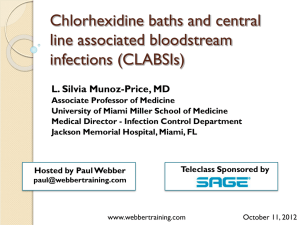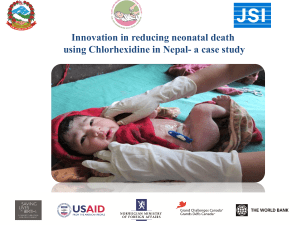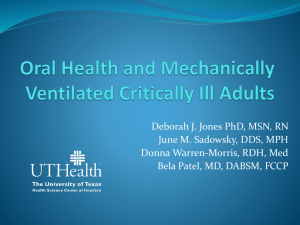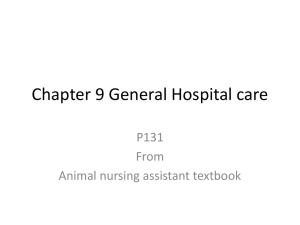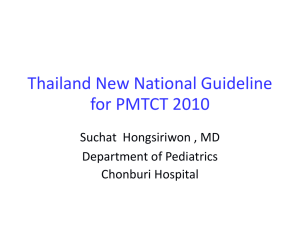Chlorhexidine and p
advertisement
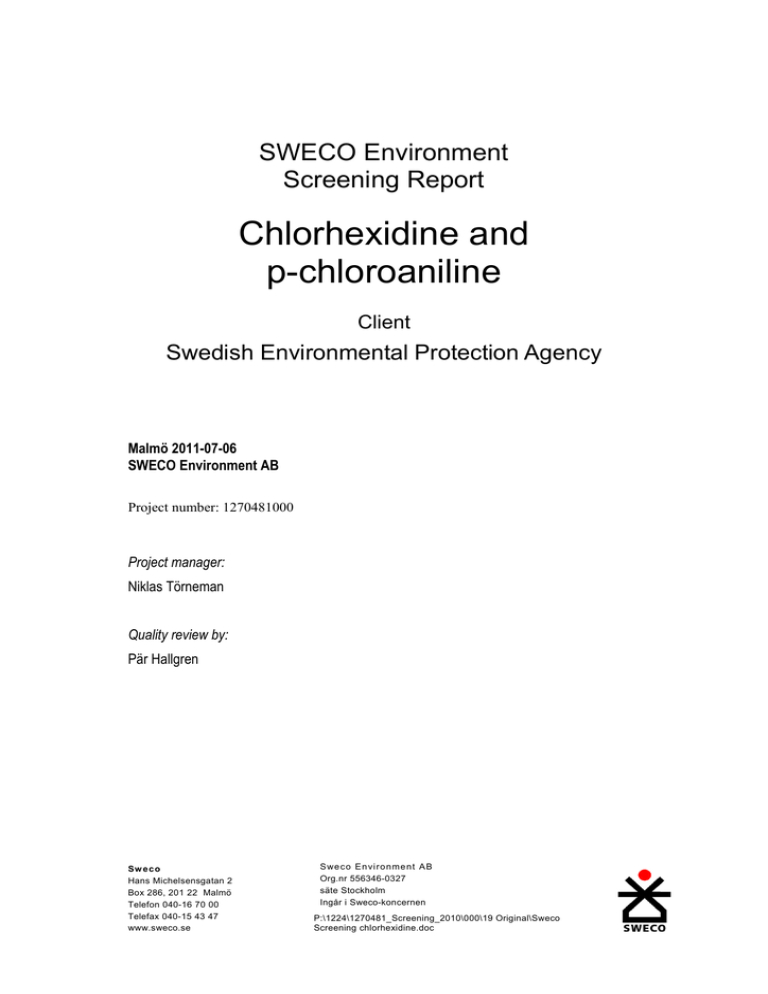
SWECO Environment
Screening Report
Chlorhexidine and
p-chloroaniline
Client
Swedish Environmental Protection Agency
Malmö 2011-07-06
SWECO Environment AB
Project number: 1270481000
Project manager:
Niklas Törneman
Quality review by:
Pär Hallgren
Sw ec o
Hans Michelsensgatan 2
Box 286, 201 22 Malmö
Telefon 040-16 70 00
Telefax 040-15 43 47
www.sweco.se
S we c o E n vi ro nme nt AB
Org.nr 556346-0327
säte Stockholm
Ingår i Sweco-koncernen
P:\1224\1270481_Screening_2010\000\19 Original\Sweco
Screening chlorhexidine.doc
SWECO ENVIRONMENT
Screening of chlorhexidine
Content
Content
Sammanfattning
Summary
1
Introduction
1.1 Background
1.2 Objectives
1.3 Substance information
1.3.1
Usage
1.3.2
Properties
1.3.3
Uptake and human metabolism
2
Methods
2.1 Additional substances
2.2 Sampling Strategy
2.3 Sampling methods
2.3.1
Sewage water
2.3.2
Sewage sludge
2.3.3
Surface water
2.3.4
Biota
2.3.5
Sediment
2.3.6
Agricultural soil
2.4 Analytical methods
2.4.1
Water samples:
2.4.2
Solid samples:
2.4.3
Biota samples:
3
Results
4
Discussion
5
Conclusions and recommendations
6
References
SWECO Environment
4
5
7
8
8
8
9
9
10
13
14
14
14
15
15
15
15
15
15
15
15
16
16
16
17
19
22
23
4
SWECO ENVIRONMENT
Screening of chlorhexidine
Sammanfattning
Bakgrund och metoder
Klorhexidin är ett vanligen använt antiseptiskt medel som används för rengöring inom vårdsektorn
samt som aktiv substans i receptfria hygienartiklar som t.ex. sårtvättsvätskor, munsköljmedel,
tandkräm, hudkräm m.m. Apotekets försäljningsstatistik redovisade att 3,2 ton av ämnet såldes under
2008. De bakteriehämmande och konserverande egenskaperna utnyttjas även genom att ämnet tillsätts
till kosmetika och andra hushållsprodukter. Under 2009 registrerades en total användning av 7,9 ton av
klorhexidin diglukonat i olika produkter enligt Kemikalieinspektionens databas KemIstat. Av denna
mängd användes 5,4 ton som biocid och för desinfektion. Den totala användningen i hela EU under år
2000 uppskattades till mellan 10 000 och 50 000 ton. Samtidigt som detta är ett ämne med utbredd
användning vet man mycket lite om eventuella förekomster i miljön av ämnet.
SWECO Environment fick i uppdrag av Naturvårdsverket att genomföra en screeningstudie av
klorhexidin. Screeningsstudien anpassades till att täcka in många olika typmiljöer och matriser, och
innefattar därför endast ett fåtal prover från varje plats. Naturvårdsverket ansvarar för den nationella
screeningen av kemikalier men Länsstyrelserna har möjligheten att vara med och komplettera
undersökningen med mätpunkter av regionalt intresse. Provtagningen genomfördes nationellt med
provpunkter som valdes av Naturvårdsverket och SWECO samt regionalt med provpunkter som valdes
av respektive länsstyrelse. Resultaten från den regionala samt den nationella provtagningen
samutvärderades.
En provtagningsstrategi togs fram innefattande provtagning av inkommande och utgående vatten samt
slam vid avloppsreningsverk liksom provtagning av ytvatten, sediment och fisk i vattendrag som tar
emot utgående vatten från avloppsreningsverk. Avloppsreningsverk valdes som provtagningsplatser
eftersom hushåll och sjukhus tros vara viktiga utsläppskällor. Då en rad ämnen med ursprung i
avloppsslam har återfunnits i åkermark analyserades även jordprov från åker. Vatten, sediment och
fiskprover från mindre belastade vattendrag har också provtagits.
Klorhexidin förmodas brytas ned till p-kloranilin som är mer toxisk än modersubstansen. Därför är det
relevant att kartlägga eventuell förekomst av även detta ämne. Genom att i studien även kvantifiera
alkylfenoler, som är ett väl kartlagt ämne med många möjliga urbana källor, kan man erhålla ett mått
på graden av urban belastning vid den aktuella mätpunkten. Sammanlagt provtogs 36 vattenprover, 11
slamprover, 7 sedimentprover, 3 jordprover och 7 fiskprover. För att ge en samlad bedömning
analyserades samtliga prover i studien med avseende på klorhexidin, p-kloranilin samt alkylfenoler.
Slutsatser och rekommendationer
De huvudsakliga slutsatserna från denna studie var att:
Klorhexidin påträffades inte i inkommande avloppsvatten till reningsverk, utgående vatten,
recepientvatten eller i vatten från bakgrundsmiljöer. Rapporteringsgränsen var 0,010 µg/l.
Den mera toxiska nedbrytningsprodukten p-kloranilin påträffades inte i inkommande
avloppsvatten till reningsverk, utgående vatten, recepientvatten eller i vatten från
bakgrundsmiljöer. Rapporteringsgränsen var 0,0050 µg/l.
SWECO Environment
5
SWECO ENVIRONMENT
Screening of chlorhexidine
Inget av ämnena detekterades i utgående avloppsvatten från sjukhus.
Inget av ämnena detekterades i avloppsslam, sediment från recipienter, sediment från
ytvatten i bakgrundsområden eller i slambelagd åkermark. Rapporteringsgränsen var
0,010 mg/kg för båda ämnena.
Inget av ämnena detekterades i muskelprover från fisk fångad i recipienter eller från ytvatten
i bakgrundsområden. Rapporteringsgränsen var 0,10 mg/kg (våtvikt) för klorhexidin och
0,050 för p-kloranilin.
Det förekommer inga tidigare studier där klorhexidin har analyserats i den yttre miljön. För
avloppsreningsverk finns endast en studie från 1988 där klorhexidin påvisats i ingående och utgående
vatten från reningsverk i halter mellan 1 – 10 g/l. Således kan inte resultaten från denna studie
bekräftas med tidigare gjorda mätningar.
Tidigare undersökningar har visat att p-kloranilin är förhållandevis lättnedbrytbart. Data vad gäller
klorhexidins (bio)nedbrytbarhet är mer motsägelsefullt, där flera studier pekar på att klorhexdidn bryts
ned av ett flertal olika bakteriestammar som dessutom isolerats från aktivt slam i reningsverk, medan
andra studier klassificerar klorhexidin som svårnedbrytbart.
Eftersom rapporteringsgränsen (LOQ) är ca 100 ggr lägre än den lägsta risknivån i ytvatten (PNECaqua)
tyder resultaten på att det inte finns några ekologiska risker associerade med klorhexidin i den
akvatiska miljön. Således är rekommendationen att inga ytterligare screeningstudier av klorhexidin är
nödvändiga.
SWECO Environment
6
SWECO ENVIRONMENT
Screening of chlorhexidine
Summary
Background and methods
Chlorhexidine is the active ingredient in many antiseptics and also a common preservative added to
e.g. make up. Because of the widespread use but lack of knowledge concerning environmental
concentrations the chemical was selected to be included in the screening program of 2010. Within this
screening program, SWECO Environment was commissioned by the Swedish EPA to measure and
report on the occurrence of chlorhexidine and it’s major degradation product p-chloroaniline.
Chlorhexidine is not labelled as a Persistent, Bioaccumulative, or Toxic chemical, PBT, but some
studies show a potential to bioaccumulate and also toxic properties. More so, the degradation product
p-chloroaniline has very toxic properties.
There are just a few previous studies world wide on the occurrence of these chemicals in the
environment. A Swedish national sampling strategy was devised which included sampling of
incoming water, effluents and sludge at sewage treatment plants as well as sampling of surface waters,
sediments and fish in streams receiving effluents from sewage treatments plants. Sewage treatment
plants (STPs) were chosen as sampling localities because of their general potential to release of
household chemicals into the aquatic environment. Further, sewage from hospitals was sampled and
also agricultural soils receiving sludge amendment.
Conclusions
The main conclusions from this investigation were:
Chlorhexidine was not found in incoming sewage water, outgoing treated water, recipient
water or background water. The limit of quantification (LOQ) was 0.010 µg/l.
p-chloroaniline (a more toxic degradation product of chlorhexidine) was not found in
incoming sewage water, outgoing treated water, recipient water or background water. The
limit of quantification was 0.0050 µg/l.
Chlorhexidine and p-chloroaniline was not detected in sewage from hospitals.
Chlorhexidine or p-chloroaniline was not found in sewage sludge, sediments in recipients,
background sediments or agricultural soil receiving sludge. The limit of quantification was
0.010 mg/kg.
Chlorhexidine or p-chloroaniline was not found in the tissue of fish collected in rivers or in
lakes. The limit of quantification was 0.10 and 0.050 mg/kg (wet weight, mussle)
respectively.
There is no data from other studies on concentrations in the environment, and only very few data on
concentrations in STPs. Consequently, there are no supporting studies to confirm the results from this
study. p–chloroaniline is known to be readily biodegradable and there is data indicating that
chlorhexidine may be inherently biodegradable in STPs although the scant information is
contradictory.
Given that LOQ is 100 times lower than PNECaqua there is no discernible risk with chlorhexidine in the
environment and there is consequently no need for further screening studies of chlorhexidine.
SWECO Environment
7
SWECO ENVIRONMENT
Screening of chlorhexidine
1 Introduction
1.1 Background
At present there is a lack of knowledge regarding the emission, distribution and exposure to many of
the chemicals emitted to the environment. The aim of the screening program financed by the Swedish
Environmental Protection Agency is to alleviate this lack of knowledge by estimating the occurrence
of different chemicals in the environment in relevant matrices (soil, water etc.).
To maximize the information gained from the screening program measurements are made in many
matrices at many sites, but with few samples per site. The Swedish EPA is responsible for the
screening at the national level and selects the chemicals that are to be included. The regional county
administrative boards have the option to complement and extend the sampling program by choosing
additional sampling point that are of regional interest.
Chlorhexidine is a common antiseptic used both in household products and in hospitals. The
chemical is not classified as a pharmaceutical compound and is therefore widely accessible.
Despite the widespread use there is a lack of knowledge concerning environmental
concentrations of chlorhexidine. Within the screening program of 2010, SWECO Environment was
commissioned by the Swedish EPA to measure the occurrence of chlorhexidine. p-chloroaniline is a
major degradation product of chlorhexidine and was therefore also included in the screening program.
1.2 Objectives
Because of the extensive lack of knowledge on environmental concentrations of chlorhexidine, the
screening project was designed to cover a wide array of matrices. Suspected major contributing
sources of chlorhexidine such as hospitals, households and sewage treatment plants (STPs) were
included in the sampling program as well as background surface water, sediment and biota. Both the
mother compound and the degradation product p-chloroaniline were monitored.
The objectives of the project were to:
Elucidate whether chlorhexidine or p-chloroaniline occurs in waste water from hospitals.
Elucidate the occurrence of chlorhexidine and p-chloroaniline in the sewage water system,
including incoming untreated water, outgoing treated sewage water and sewage sludge.
Agricultural soil receiving sewage sludge was also included.
Elucidate the occurrence of chlorhexidine and p-chloroaniline in water, sediments and biota of
recipients downstream of STPs.
Elucidate levels of chlorhexidine or p-chloroaniline in water, sediments and biota in urban
lakes and rivers
Elucidate whether chlorhexidine or p-chloroaniline is occurring in background surface waters
and sediments.
SWECO Environment
8
SWECO ENVIRONMENT
Screening of chlorhexidine
1.3 Substance information
1.3.1 Usage
Chlorhexidine is one of the most widely used antimicrobial agents (Ranganathan 1996).
It is a cationic antiseptic belonging to biguanidic group and is active against gram-positive bacteria,
fungi, species of Proteus and also certain types of viruses (Fiorentino 2010). Chlorhexidine has good
antiseptic abilities and is possible to incorporate into many different types of products (Fiorentino
2010). This has led to a widespread use in many types of products. It can be found in consumer
products such as cosmetics, gels, spray, gum, soaps, mouth wash and toothpaste. Chlorhexidine and its
salts (chlorhexidine acetate, chlorhexidine gluconate, chlorhexidine hydrochloride) may be added to
cosmetics, as active ingredients or as preservatives, at concentrations of up to 0.3 %, according to
current EU legislation (Council Directive 76/768/EEC). In clinical practice chlorhexidine is used for
washing of hands, skin, mucous membranes, wounds and burns. It is also used as a disinfectant for
veterinary use (Fiorentino 2010). Another use of chlorhexidine is as a preservative to disinfect
hydrophilic contact lenses (Akaho 2001).
The annual consumption of chlorhexidine in the EU was 10´000-50´000 tonnes in 2000
(Flygfältsbyrån 2009). A reliable estimate of the annual national consumption of chlorhexidine in
Sweden is difficult since the use in cosmetic and hygiene products does not need to be reported to the
Swedish chemical agency (KIFS 2008:245). The usage as an additive in these kinds of products is
probably a substantial part of the overall use. Estimated use of chlorhexidine digluconate in 2009 was
7.9 tonnes (KemIstat) of which 5.4 tonnes were used for disinfection and biocide use. Data for
chlorhexidine digluconate was also found in the SPIN data base and the trend for annual consumption
as reported in these two databases are presented in Figure 1.1. No data for Swedish consumption of
pure chlorhexidine, chlorhexidine dihydrochloride or chlorhexidine diacetate were available from
these databases. According to FASS, the Swedish Medicines Information Engine, there are presently
27 different products registered with chlorhexidine as active component. Typical products are
cutaneous disinfectants and mouth wash.
SWECO Environment
9
60
chlorhexidine digluconate (KemiStat)
50
chlorhexidine digluconate (SPIN)
40
30
20
10
0
19
92
19
93
19
94
19
95
19
96
19
97
19
98
19
99
20
00
20
01
20
02
20
03
20
04
20
05
20
06
20
07
20
08
20
09
estimated annual consumption (tonnes)
SWECO ENVIRONMENT
Screening of chlorhexidine
Figure 1.1 Registered sales (tonnes) of chlorhexidine in Sweden (KEMI 2010).
1.3.2 Properties
Table 1.1 presents physical and chemical properties as well as toxicological and ecotoxicological
information for chlorhexidine.
Based on the physiochemical properties chlorhexidine in its pristine form is not expected to adsorb to
suspended solids. The pKa of 10.78 indicates that the protonated form of chlorhexidine will be the
dominating form in the environment and this di-cation can be expected to adsorb to suspended solids
in e.g. sewage water. Reports on bioaccumulation and bioconcentrarion of chlorhexidine are
contradictory. The estimated log Kow of 0.08 and the estimated BCF of 3 suggests that the potential to
bioconcentrate in aquatic organisms is low (Toxnet, HSDP). The QSAR modelling performed before
the present study suggests a Kow of 4.82 indicating that Chlorhexidine bioconcentrate and
bioaccumulate in the aquatic environment (Flygfältsbyrån 2009). If the latter modelling is based on the
neutral and not protonated form of chlorhexidin this can be an explanation for the non-coherent
results. The estimation for the protonated molecule is the only relevant one, since chlorhexidin has a
pKa > 10 and can therefore be expected to be present in water in its protonated hydrophilic form.
Experimental data from an exposure study with golden eye (Leuciscus idus melanotus) resulted in a
bioaccumulation factor of 40 (Freitag 1985). It has also been shown that chlorhexidine can
bioaccumulate extensively in lipid-rich regions of diatoms and bacteria in natural river biofilms
(Dynes 2006).
Chlorhexidine is a common disinfectant used in many hospitals and health care workers are repeatedly
exposed to it. Dilute solutions does not seem to cause allergenic response. A dilute solution of 0.01%
chlorhexidine diacetate can however be irritating to eye and mucous membranes and more
concentrated solutions are highly acutely toxic when applied to the eye (Toxnet 2010). More
SWECO Environment
10
SWECO ENVIRONMENT
Screening of chlorhexidine
importantly p-chloroaniline, which is the major degradation product of chlorhexidine, has more toxic
properties. p-chloroaniline causes the formation of haemoglobin adducts in humans. Further it is
proven to be carcinogenic in male rats and there is also some evidence of carcinogenicity in male
mice. Possibly, p-chloroaniline is also genotoxic, although results are sometimes conflicting. To
aquatic organisms p-chloroaniline can be classified as moderately to highly toxic (Toxnet 2010).
SWECO Environment
11
SWECO ENVIRONMENT
Screening of chlorhexidine
Table 1.1 Physiochemical and (Eco)toxicological properties of Chlorhexidine.
Common name
Chlorhexidine
Name
1,1´-hexamethylenebis
{5–(p-chlorophenyl) biguanide}
CAS #
55-56-1
Labelling1
[Xi - Irritant: R36, R37, R38], [N - Harmful for the environment: R51/R53]
Min
Physico-chemical properties
Max
800 at 20°C 2
Water solubility
0.08
Koc
28 2
pKa
10.78 2
Henry’s law constant
1.1X10-30
atm-cu
m/mole
2.0X10-1
(Estimated)
mm Hg @
25 deg C
2
LC50 Pteronarcys (stone fly) 48h 2
0.5
LC50 Salmo gairdneri 96h
2
1.3
LC50 Daphnia magna 48h
2
250
LC50 Daphnia magna 25h
2
LC50 Brachydanio rerio 96h
EC50 Daphnia magna
EC50 Daphnia pulex
740
2
1400
3
50 – 100
4
11
PNECaqua7
1.4
Toxicology
LD50 Mouse (male/female) oral – iv2
1-3
Persistence, Bioaccumulation,
Toxicity (PBT)
Chlorhexidine is classified as nonbiodegradable and BCF has been
estimated to 3 2
1
http://sitem.herts.ac.uk/aeru/vsdb/Reports/1779.htm
2
Toxnet, Hazardous Substances Data Bank
3
EPA. Reregistration Eligibility Decision (RED) Chlorhexidine diacetat. 1996. USEPA. www.epa.org.
4
MSDS, Fagron GmbH & Co.KG, version: 26.11.2008
6
Product Safety Data Sheet, Vetasept Chlorhexidine Surgical Scrub, Animalcare UK.
7
Envision Chemistry/Peter Frisk Associates ,Development and assessment of risk profiles for pharmaceuticals
12
µg/l
60
6
IC50 Chronic algal toxicity 72h
SWECO Environment
mg/l
2
Log Kow
Vapour pressure
Ecotoxicology aquatic
Unit
g/kg
SWECO ENVIRONMENT
Screening of chlorhexidine
1.3.3 Uptake and human metabolism
The most probable route of exposure for humans to Chlorhexidine is by dermal contact with skin
disinfectants or ingestion of oral antimicrobial products. Chlorhexidine does not absorb readily
through the skin after application and is absorbed poorly from the gastrointestinal tract. If accidentally
swallowed, it has been shown that of a 300-mg dose of chlorhexidine gluconate, approximately 90%
of the dose is excreted in faeces and less than 1% is eliminated in urine (Toxnet 2009).
SWECO Environment
13
SWECO ENVIRONMENT
Screening of chlorhexidine
2 Methods
2.1 Additional substances
Apart from chlorhexidine and p-chloroaniline, alkyl phenols were also analysed in each sample. Alkyl
phenols were chosen as substances that could represent anthropogenic influence in general. This was
done to support the evaluation since levels of chlorhexidine may roughly correlate to anthropogenic
influence.
2.2 Sampling Strategy
Since household consumption and hospital use is considered to be the main source of chlorhexidine a
sampling strategy was devised to elucidate the levels of chlorhexidine within sewage treatment plants
(STPs) and in receiving surface water recipients. Locations were selected to give a broad geographical
spread and one treatment plant was selected specifically because it receives waste water from a
pharmaceutical company that produces a chlorhexidine containing product. Agricultural soil receiving
sludge amendments were also sampled.
Apart from the sampling and analysis financed by the Swedish EPA, regional county administration
boards financed sampling and analysis of additional samples, mostly in sewage treatment plants.
The different matrices chosen and types of sampling points are presented in Table 2.1.
Table 2.1 Sampling matrices and the types of samples investigated for the occurrence of Chlorhexidine and pchloroaniline.. The first value denotes samples taken within the national screening program. The second value
(after the slash) denotes samples financed by the regional screening program.
Sample matrices Chlorhexidine and p-chloroanlinine
Incoming
Outgoing
water
water
Sludge
Background
Sewage treatment plant
6/4
6 / 10
6/5
Urban effected areas
Surface
Sediment
Biota
1
1
1
3/2
3
2
3/3
3
2/2
water
Agricultural land
Total
3
6/4
6 / 10
6/5
Total
SWECO Environment
Soil
7/5
7
40 / 26
14
5/2
3
SWECO ENVIRONMENT
Screening of chlorhexidine
2.3 Sampling methods
Sampling instructions were given to all sampling personnel. The instructions included sampling
procedures and handling of samples.
2.3.1 Sewage water
The staff at the sewage treatment plants collected water samples in glass containers or stainless steel
containers. Plastic containers were avoided to exclude cross-contamination of alkyl phenols. A time
integrated, or flow-proportional, pooled sample was collected for 4-7 days often in coordination with
the ongoing operational monitoring program. Samples were kept cool until analysis. A volume of 1
litre of the sample was analyzed for chlorhexidine and p-chloroaniline and in addition a volume of 0.5
litre was analyzed for alkyl phenols.
2.3.2 Sewage sludge
The staff at the sewage treatment plants collected untreated sludge samples in acid rinsed pre burned
dark glass jars. A pooled sludge sample was collected to represent approximately the same time span
as the sewage samples but may in some cases, due to the operational procedures, represent a somewhat
longer time span.
2.3.3 Surface water
Pooled grab samples of unfiltrated water was collected in clean glass bottles. Water samples were
stored cold until analysis. A volume of 1 litre of the sample was analyzed for chlorhexidine and
p-chloroaniline and in addition a volume of 0.5 litre was analyzed for alkyl phenols.
2.3.4 Biota
All biota samples except from Höje å, Lund, consisted of 50 gram of pooled muscle sample from 5-10
individuals of perch (Perca fluviatilis). The sample from Lund consisted of pooled muscle from 2 carp
fish (Cyprinus carpio).
2.3.5 Sediment
Sediment samples were collected by means of a core sampler or Ekman dredge. All sediment samples
were transferred to pre-burned and dark glass jars. They were stored cold until analysis.
2.3.6 Agricultural soil
Agricultural soil was sampled two months after sewage sludge had been spread. Samples from at least
3 sub-samples were pooled.
2.4 Analytical methods
As mentioned above there are very few studies on environmental concentrations of chlorhexidine.
Most of the available analytical methods have been developed for the medical industry and
subsequently are designated for the analysis of chlorhexidine in saliva, urine or medical products such
as creams and washing solutions. In a review of analytical methods no method for measurement in
environmental samples was identified (Fiorentino 2010). Consequently, new methods for the analysis
SWECO Environment
15
SWECO ENVIRONMENT
Screening of chlorhexidine
of chlorhexidine was developed and validated for the purpose of this study. The validation process
encompassed:
1. A complete calibration test over the whole quantification range to ensure a linear response.
2. A 10 point calibration for the lower quantification range to determine LOQ and LOD (limit of
detection).
3. Separate recovery test for all matrices in three concentration levels (low, medium, high). Each
concentration level was in turn tested by triplicate spiking and analysis.
2.4.1 Water samples:
After adjustment to basic pH ( >10). water samples were extracted with dichloromethane. The extract
was treated with 6M HCl which hydrolyses chlorhexidine to two p-chloroaniline molecules. pH was
then adjusted to basic once again and the sample was evaporated before a second extraction of
p chloroaniline with cyclohexane. (If only p-chloroaniline is to be measured in the sample the
hydrolysis step is omitted). Quantification of p-chloroaniline was made by GCMS.
2.4.2 Solid samples:
Chlorhexidine in sludge, sediment or soil was determined after air-drying of samples. Dry samples
were extracted with dichloromethane after alkalinisation of the material (ph >10). Extracts were
evaporated to dryness and then hydrolyzed with 6 M HCl over night. pH was then adjusted to basic
once again and the sample was evaporated before a second extraction of p-chloroaniline with
cyclohexane. Quantification of p-chloroaniline was made by GCMS.
2.4.3 Biota samples:
Chlorhexidine in fish was determined after alkalization of the original fish material (ph >10), followed
by centrifugation and decantation. The liquid phase was extracted with dichloromethane and the
extract was then treated like described above for water and solid samples.
SWECO Environment
16
SWECO ENVIRONMENT
Screening of chlorhexidine
3 Results
The complete list of sampling points and results are presented in Appendix 1.
Neither chlorhexidine nor p-chloraniline was detected in any of the 38 water samples, 11 sludge
samples, 7 sediment samples, 3 soil samples or 7 fish samples. Limit of quantification (LOQ) for the
determination of chlorhexidine and p-chloroaniline in the different matrices are presented in Table 3.1.
Data on alkyl phenols, as determined for reference, in the same samples are presented in Table 3.2.
Table 3.1 LOQ for the present study of chlorhexidine.
Matrix
unit
LOQ
Chlorhexidin,
present study
LOQ
p-Chloroaniline,
present study
number of
samples
Incoming sewage water
µg/l
<0.010
<0.005
10
Sludge
mg/kg
< 0.010
<0.010
11
Outgoing sewage water
µg/l
<0.010
<0.005
14
Surface water
downstream STP
µg/l
<0.010
<0.005
5
Surface water
µg/l
<0.010
<0.005
7
Sediment
mg/kg
< 0.010
<0.01
7
Fish
mg/kg
<0.10
<0.05
7
Agricultural soil
mg/kg
< 0.010
<0.01
3
Table 3.2 Alkyl phenols in the present study.
Matrix
unit
LOQ
Alkyl phenols,
present study
Concentration
Alkyl phenols*,
present study
n – n.o. detected
m - median among detected
25th - 25 percentile among detected
95th - 95 percentile among detected
Incoming sewage water
µg/l
<0.3
n = 10; m = 1.60; 25th = 1.10; 95th = 2.54
10
Sludge
mg/kg
-
n = 10; m = 6.8; 25th 3.1; 95th = 11.6
10
Outgoing sewage water
µg/l
<0.3
n = 11; m = 0.50; 25th = 0.39; 95th = 1.18
16
Surface water
downstream STP
µg/l
<0.010
n = 2 (“Norrån” = 1.10 ; “Kaplansälven” = 3.88)
5
Surface water
µg/l
<0.3
n=0
7
Sediment
mg/kg
< 0.010
n = 1 (“Källby” = 3.74)
7
SWECO Environment
17
number of
samples
SWECO ENVIRONMENT
Screening of chlorhexidine
Matrix
unit
LOQ
Alkyl phenols,
present study
Concentration
Alkyl phenols*,
present study
n – n.o. detected
m - median among detected
25th - 25 percentile among detected
95th - 95 percentile among detected
number of
samples
Fish
mg/kg
<0.011
n = 1 (“Källby” = 0.54)
7
Agricultural soil
mg/kg
< 0.005
n=0
3
* For water samples data represent the sum of nonyl phenols not including 4-n-nonylfenol, for solid matrices data
represent the sum of 4-tert-octyl phenol + 4-nonyl phenol
All samples were also analyzed for Alkyl phenols as substances that could represent anthropogenic
influence in general. Alkyl phenols (4-tert-octyl phenol + 4-nonyl phenol) were detected in all
analysed samples of incoming sewage water and sludge samples. Analyzed sediment samples were
both from background areas and sites located downstream of STPs. The sediment sample “Källby”,
where alkyl phenols were detected, was taken from the first treatment dam at the sewage treatment
plant. This is the first of three sequential polishing steps handling water after the treatment basins. The
fish sampled named “Källby” was from two Carp fish from the same closed dam. These sediment and
biota samples do not represent the final recipient stream of Höje å but rather an integral part of the
water treatment steps at the plant.
SWECO Environment
18
SWECO ENVIRONMENT
Screening of chlorhexidine
4 Discussion
The reported absence of any detectable concentrations of chlorhexidine or p-chloraniline in the whole
screening study motivated a deeper inspection of the analytical methods. The following measures were
taken to rule out the possibility of false negatives being reported.
The laboratory was asked to provide more detailed information regarding the analytical
method.
A comprehensive review of previous methods reported in peer reviewed papers was
conducted
Several merited researchers in analytical chemistry at Lund University were interviewed
concerning suitable extraction methods for the present analysis.
Laboratory chromatograms from the method validation, calibration and from some of the
samples were reviewed.
Initially there was a concern for that the extraction procedure for water samples was erroneous.
However, after a very detailed description of the steps involved in the extraction procedure had been
provided by the laboratory, the initial concern could be precluded.
There is a paucity of information concerning chlorhexidine concentrations in the environment.
Kodama et al. (1988) reported that domestic wastewater could contain up to 1.6 to 10.3 g/1. But apart
from this study there is little, if any, data available. For p-chloroanliline there are more data available
concerning environmental concentrations estimated in other studies and some of these are presented in
Table 4.1 together with the LOQ for determination of p-chloroaniline in different matrices in the
present study.
Among the studies presented in Table 4.1 it can be noted that in the most recent studies, from 1995
and 1998, p-chloroaniline was not detected in the river Rhine or in the river Elbe downstream the city
of Hamburg.
SWECO Environment
19
SWECO ENVIRONMENT
Screening of chlorhexidine
Table 4.1 Concentrations of p-chloroaniline in studies from other countries.
Matrix
unit
present
study
Incoming sewage water
µg/l
<0.0050
Sludge
mg/kg
< 0.010
Outgoing sewage water
µg/l
<0.0050
Surface water
µg/l
<0.0050
other studies
Year/Country
Reference
0,1 – 1
summary 1980-1995
/Germany and the
Netherlands, Rhine
a
0.024 - 0.39
(detected in 9 of 128
samples)
Japan
b
<0.002
<0.5
0.84
1998/Germany, Elbe
1995/Germany, Rhine
1995/Germany, Emscher
c
d
d
Sediment
mg/kg
< 0.010
0,001 - 0,27
(detected in 39 of 121)
1976/Japan
b
Fish
mg/kg
<0.050
<1
1976/Japan
b
Agricultural soil
mg/kg
< 0.010
a
BUA (1995) p-Chloroaniline. Beratergremium für Umweltrelevante Altstoffe (BUA) der Gesellschaft Deutscher
Chemiker. Weinheim, VCH, 171 pp. (BUA Report 153)
b
Office of Health Studies (1985) Chemicals in the environment. Report on environmental survey and wildlife monitoring
in F.Y. 1982 and 1983. Tokyo, Environment Agency Japan, 9 pp.
c
Götz R, Bauer OH, Friesel P, Roch K (1998) Organic trace compounds in the water of the river Elbe near Hamburg
part-1. Chemosphere, 36(9):2085-2101.
d
LUA (1997) Rheingütebericht NRW 1995. Essen, Landesumweltamt
Nordrhein-Westfalen
In the present study neither chlorhexidine nor its major degradation product p-chloroaniline was
detected in any of the investigated matrices. The sampling strategy incorporated a wide array of
sample types including both general background samples and specially selected locations with
possible point source influence. Among the latter was e.g. untreated sewage water that included water
from a medical industry known to use chlorhexidine in the production. The methods for quantification
of chlorhexidine and p-chloroaniline were developed specifically for the present study and have been
thoroughly validated. The limit of quantification for measurement in water was more than 100 times
lower than the PNECaqua. The toxicological data on which the PNEC was based was not accessible.
The PNEC is approximately similar for p-chloroaniline (WHO 2003).
The limit of quantification was 100 times lower then the two lowest found LC50 values. These LC50
values, that were lower than the PNEC, were not used for the calculation of a new PNEC since the
primary source for the studies were not accessible. It does not seem likely that the lethal concentration
for salmon is 1000 times lower than that for zebra fish.
SWECO Environment
20
SWECO ENVIRONMENT
Screening of chlorhexidine
The levels of alkyl phenols found in fish tissue from the Källby STP (taken from a treatment dam)
indicates that this biota sample was relevant for pinpointing which chemicals present at the site that
are prone to bioaccumulate. If chlorhexidine had been present in relevant concentrations, and been
prone to bioaccumulate, it would probably have been detected in this biota sample.
The present screening study of chlorhexidine was motivated mostly by the widespread use of the
chemical and the lack of knowledge concerning environmental concentrations. The results indicate
that chlorhexidine and p-chloroaniline is either diluted to concentrations below what is quantifiable
with present analytical methods or eliminated effectively by biotic and/or abiotic degradation. The
quotes on degradation of chlorhexidine are somewhat conflicting. A review on the fate of
pharmaceutical substances in the environment states that chlorhexidine is not easily degradable in
sewage treatment plants (Halling-Sorensen et al. 1998). On the other hand Japanese studies have
showed that bacterial strains have the ability to degrade chlorhexidine via the intermediate degradation
product p-chloraniline (Ogase et al 1992) but also via other previously unknown intermediate
degradation products (Tanaka et al 2005). In a study by Kido et al. (1988) two bacterial strains, who
were able to use chlorhexidine as sole nitrogen source for growth, were isolated from activated sludge
from a STP. Abiotic degradation through hydrolysis is not expected in the environment due to the lack
of hydrolyzable functional groups (Lyman 1990) but degradation by light has been reported (Freitag
1985).
The degradation product p-chloroaniline, is less stable in the environment in comparison to the parent
compound and numerous studies indicate that p-chloroaniline is inherently biodegradable in water
under aerobic conditions. It decomposes in the presence of light and air and at elevated temperature
(WHO 2003). Effective degradation of anilines in sludge has also been demonstrated elsewhere
(Gledhil 1975).
On the basis of what is known concerning the degradation of both chlorhexidine and p-chloroaniline, it
is quite possible that the prevailing conditions in Swedish sewage treatment plants are favourable for
elimination of these compounds.
SWECO Environment
21
SWECO ENVIRONMENT
Screening of chlorhexidine
5 Conclusions and
recommendations
This study indicates that chlorhexidine and its major degradation product p-chloroaniline does not
occur above the limit of quantification in any matrix in the vicinity of the possible sources as
identified in this study. There is no data from other studies on concentrations in the environment, and
only very few data on concentrations in STPs. Consequently, there are no supporting studies to
confirm the results from this study. p–chloroaniline is known to biodegrade easily and there is data
indicating that chlorhexidine may be inherently biodegradable in STPs although the scant information
is contradictory.
Given that LOQ is 100 times lower than PNECaqua there is no discernible risk with chlorhexidine in the
environment. There is consequently no need for further screening studies of chlorhexidine.
SWECO Environment
22
SWECO ENVIRONMENT
Screening of chlorhexidine
6 References
Akaho, E. Fukimori, Y. 2001. Studies on Adsorption Characteristics and Mechanism of
Adsorption of Chlorhexidine Mainly by Carbon Black. Journal of Pharmaceutical Sciences, Vol. 90,
1288±1297
Boxall ABA et al. (2004). Rev Environ Contam Toxicol 180: 1-91
Dynes JJ, Lawrence JR, Korber DR, Swerhone GD, Leppard GG, Hitchcock AP.
(2006) Quantitative mapping of chlorhexidine in natural river biofilms.
Sci Total Environ. Oct 1;369(1-3):369-83.
Freitag D et al (1985); Chemosphere 14: 1589-616
Flygfältsbyrån (2009). Litteraturstudie inför Naturvårdsverkets screening 2010. Rapport
konsultuppdrag 162070.
Freitag D et al (1985). Chemosphere 14: 1589-616
Gledhil, W. E. 1975. Water Research Vol. 9, pp. 649 to 654
Halling-Sorensen et al. 1998. Occurrence, Fate and Effects of Pharmaceutical Substances in the
environment - A review. Chemosphere. Vol 36. Nr 2. 357-393.
Kodama, et al. 1988. Microbial degradation of disinfectants. IV. Treatment by activated sludge of
chlorhexidine. Eisei Kagaku 34:408–413. (Abstract)
Lyman WJ et al (1990); Handbook of Chemical Property Estimation Methods. Washington, DC: Amer
Chem Soc pp. 7-4, 7-5.
Másquio Fiorentino, Flávia Angélica , Corrêa, Marcos Antonio and Nunes Salgado, Hérida
Regina (2010) Analytical Methods for the Determination of Chlorhexidine: A Review,
Critical Reviews in Analytical Chemistry, 40: 2, 89 — 101
Ogase, H. Nagai, K. Kamedal, Kumel, S. and Ono, S. (1992). Identification and quantitative analysis
of degradation products of chlorhexidine with chlorhexidine-resistant bacteria with three dimensional
high performance liquid chromatography. Journal of Applied Bacteriology, 73, 71-78
Ranganathan NS (1996). Chlorhexidine. In: Ascenzi JM, editor. Handbook of disinfection and
antiseptics. New York, NY: Marcel Dekker Inc.; p. 235–64.
Tanaka, T. et al. (2005) Microbial degradation of disinfectants. A new chlorhexidine
degradation intermediate (CHDI), CHDI-C, produced by Psuedomonas sp. Strain No. A-3.
Journal of Health Science. 51(3) p357-361.
SWECO Environment
23
SWECO ENVIRONMENT
Screening of chlorhexidine
Toxnet, HSDP - Hazardous Substances Data Bank . http://toxnet.nlm.nih.gov
World Health Organization (2003) Concise International Chemical Assessment Document 48
4-CHLOROANILINE
SWECO Environment
24
Appendix 1, Results Screening 2010 - 2011
Chlorhexidine (including the degradation product p-chloraniline) and Alkyl phenols
Incoming sewage water
compound
county
chlorhexidine
Dalarna
chlorhexidine
Dalarna
chlorhexidine
Dalarna
chlorhexidine
Gävleborg
chlorhexidine
Södermanland
chlorhexidine
Södermanland
chlorhexidine
Värmland
chlorhexidine
Värmland
chlorhexidine
Västernorrland
chlorhexidine
Dalarna
national/regional
N
N
R
N
R
R
N
N
N
R
Sample name/location
Krylbo ARV, inkommande avloppsvatten
Borlänge ARV, inkommande avloppsvatten
Främby ARV, inkommande avloppsvatten
Hedåsen ARV, inkommande avloppsvatten
Strängnäs ARV, inkommande avloppsvatten
Ekeby ARV, inkommande avloppsvatten
Fiskartorpet ARV, inkommande avloppsvatten
Sjöstadsverket ARV, inkommande avloppsvatten
Bällsta ARV, inkommande avloppsvatten
Främby ARV, inkommande avloppsvatten (tankbil)
Concentration
<0,01
<0,01
<0,01
<0,01
<0,01
<0,01
<0,01
<0,01
<0,01
<5
Unit
µg/L
µg/L
µg/L
µg/L
µg/L
µg/L
µg/L
µg/L
µg/L
µg/L
p-chloroaniline
p-chloroaniline
p-chloroaniline
p-chloroaniline
p-chloroaniline
p-chloroaniline
p-chloroaniline
p-chloroaniline
p-chloroaniline
p-chloroaniline
Dalarna
Dalarna
Dalarna
Gävleborg
Södermanland
Södermanland
Värmland
Värmland
Västernorrland
Dalarna
N
N
R
N
R
R
N
N
N
R
Krylbo ARV, inkommande avloppsvatten
Borlänge ARV, inkommande avloppsvatten
Främby ARV, inkommande avloppsvatten
Hedåsen ARV, inkommande avloppsvatten
Strängnäs ARV, inkommande avloppsvatten
Ekeby ARV, inkommande avloppsvatten
Fiskartorpet ARV, inkommande avloppsvatten
Sjöstadsverket ARV, inkommande avloppsvatten
Bällsta ARV, inkommande avloppsvatten
Främby ARV, inkommande avloppsvatten (tankbil)
<0,005
<0,005
<0,005
<0,005
<0,005
<0,005
<0,005
<0,005
<0,005
<1
µg/L
µg/L
µg/L
µg/L
µg/L
µg/L
µg/L
µg/L
µg/L
µg/L
nonyl phenols
nonyl phenols
nonyl phenols
nonyl phenols
nonyl phenols
nonyl phenols
nonyl phenols
nonyl phenols
nonyl phenols
nonyl phenols
Gävleborg
Värmland
Dalarna
Södermanland
Dalarna
Västernorrland
Dalarna
Värmland
Gävleborg
Södermanland
N
N
N
N
N
N
N
N
N
N
Hedåsen ARV, inkommande avloppsvatten
Sjöstadsverket ARV, inkommande avloppsvatten
Borlänge ARV, inkommande avloppsvatten
Strängnäs ARV, inkommande avloppsvatten
Främby ARV, inkommande avloppsvatten
Bällsta ARV, inkommande avloppsvatten
Krylbo ARV, inkommande avloppsvatten
Fiskartorpet ARV, inkommande avloppsvatten
Österfärnebo ARV, inkommande avloppsvatten
Ekeby ARV, inkommande avloppsvatten
2,600
2,300
1,600
1,600
1,100
0,980
0,840
0,840
0,810
0,58
µg/L
µg/L
µg/L
µg/L
µg/L
µg/L
µg/L
µg/L
µg/L
µg/L
Appendix 1 Chlorhexidine
2011-06-30
1 (6)
P:\1224\1270481_Screening_2010\000\10 Arbetsmtrl_dok\Mätn_Analys\Provpunkter och resultat.xls
Outgoing sewage water
compound
county
chlorhexidine
Dalarna
chlorhexidine
Dalarna
chlorhexidine
Dalarna
chlorhexidine
Dalarna
chlorhexidine
Dalarna
chlorhexidine
Gotland
chlorhexidine
Gävleborg
chlorhexidine
Gävleborg
chlorhexidine
Skåne
chlorhexidine
Stockholm
chlorhexidine
Södermanland
chlorhexidine
Södermanland
chlorhexidine
Uppsala
chlorhexidine
Värmland
chlorhexidine
Värmland
chlorhexidine
Västernorrland
national/regional
R
R
R
R
R
R
N
N
N
N
R
R
N
R
R
N
Sample name/location
Avesta lasarett, utgående avloppsvatten
Krylbo ARV, utgående avloppsvatten
Borlänge ARV, utgående avloppsvatten
Falu lasarett, utgående avloppsvatten
Främby ARV, utgående avloppsvatten
Visby ARV, utgående avloppsvatten
Österfärnebo ARV, utgående avloppsvatten
Gysinge ARV, utgående avloppsvatten
Källby ARV, utgående avloppsvatten
Henriksdal ARV, utgående avloppsvatten
Strängnäs ARV, utgående avloppsvatten
Ekeby ARV, utgående avloppsvatten
Tärnsjö ARV, utgående avloppsvatten
Fiskartorpet ARV, utgående avloppsvatten
Sjöstadsverket ARV, utgående avloppsvatten
Bällsta ARV, utgående avloppsvatten
Concentration
<0,01
<0,01
<0,01
<0,01
<0,01
<0,01
<0,01
<0,01
<0,01
<0,01
<0,01
<0,01
<0,01
<0,01
<0,01
<0,01
Unit
µg/L
µg/L
µg/L
µg/L
µg/L
µg/L
µg/L
µg/L
µg/L
µg/L
µg/L
µg/L
µg/L
µg/L
µg/L
µg/L
p-chloroaniline
p-chloroaniline
p-chloroaniline
p-chloroaniline
p-chloroaniline
p-chloroaniline
p-chloroaniline
p-chloroaniline
p-chloroaniline
p-chloroaniline
p-chloroaniline
p-chloroaniline
p-chloroaniline
p-chloroaniline
p-chloroaniline
p-chloroaniline
Dalarna
Dalarna
Dalarna
Dalarna
Dalarna
Gotland
Gävleborg
Gävleborg
Skåne
Stockholm
Södermanland
Södermanland
Uppsala
Värmland
Värmland
Västernorrland
R
R
R
R
R
R
N
N
N
N
R
R
N
R
R
N
Avesta lasarett, utgående avloppsvatten
Krylbo ARV, utgående avloppsvatten
Borlänge ARV, utgående avloppsvatten
Falu lasarett, utgående avloppsvatten
Främby ARV, utgående avloppsvatten
Visby ARV, utgående avloppsvatten
Österfärnebo ARV, utgående avloppsvatten
Gysinge ARV, utgående avloppsvatten
Källby ARV, utgående avloppsvatten
Henriksdal ARV, utgående avloppsvatten
Strängnäs ARV, utgående avloppsvatten
Ekeby ARV, utgående avloppsvatten
Tärnsjö ARV, utgående avloppsvatten
Fiskartorpet ARV, utgående avloppsvatten
Sjöstadsverket ARV, utgående avloppsvatten
Bällsta ARV, utgående avloppsvatten
<0,005
<0,005
<0,005
<0,005
<0,005
<0,005
<0,005
<0,005
<0,005
<0,005
<0,005
<0,005
<0,005
<0,005
<0,005
<0,005
µg/L
µg/L
µg/L
µg/L
µg/L
µg/L
µg/L
µg/L
µg/L
µg/L
µg/L
µg/L
µg/L
µg/L
µg/L
µg/L
nonyl phenols
nonyl phenols
nonyl phenols
nonyl phenols
nonyl phenols
nonyl phenols
nonyl phenols
nonyl phenols
nonyl phenols
nonyl phenols
nonyl phenols
nonyl phenols
nonyl phenols
nonyl phenols
nonyl phenols
nonyl phenols
Gävleborg
Gävleborg
Dalarna
Västernorrland
Dalarna
Uppsala
Värmland
Dalarna
Dalarna
Södermanland
Skåne
Dalarna
Gotland
Stockholm
Södermanland
Värmland
N
N
N
N
N
N
N
N
N
N
N
N
N
N
N
N
Gysinge ARV, utgående avloppsvatten
Österfärnebo ARV, utgående avloppsvatten
Krylbo ARV, utgående avloppsvatten
Bällsta ARV, utgående avloppsvatten
Borlänge ARV, utgående avloppsvatten
Tärnsjö ARV, utgående avloppsvatten
Sjöstadsverket ARV, utgående avloppsvatten
Falu lasarett, utgående avloppsvatten
Avesta lasarett, utgående avloppsvatten
Strängnäs ARV, utgående avloppsvatten
Källby ARV, utgående avloppsvatten
Främby ARV, utgående avloppsvatten
Visby ARV, utgående avloppsvatten
Henriksdal ARV, utgående avloppsvatten
Ekeby ARV, utgående avloppsvatten
Fiskartorpet ARV, utgående avloppsvatten
1,700
0,660
0,620
0,590
0,500
0,500
0,490
0,410
0,370
0,360
0,330
<0,3
<0,3
<0,3
<0,3
<0,3
µg/L
µg/L
µg/L
µg/L
µg/L
µg/L
µg/L
µg/L
µg/L
µg/L
µg/L
µg/L
µg/L
µg/L
µg/L
µg/L
Appendix 1 Chlorhexidine
2011-06-30
2 (6)
P:\1224\1270481_Screening_2010\000\10 Arbetsmtrl_dok\Mätn_Analys\Provpunkter och resultat.xls
Surface water
compound
chlorhexidine
chlorhexidine
chlorhexidine
chlorhexidine
chlorhexidine
chlorhexidine
chlorhexidine
chlorhexidine
chlorhexidine
chlorhexidine
chlorhexidine
chlorhexidine
county
Södermanland
Dalarna
Gävleborg
Södermanland
Västernorrland
Värmland
Värmland
Södermanland
Gotland
Södermanland
Västra Götalan
Dalarna
national/regional
R
N
N
R
N
N
N
R
R
R
N
N
p-chloroaniline
p-chloroaniline
p-chloroaniline
p-chloroaniline
p-chloroaniline
p-chloroaniline
p-chloroaniline
p-chloroaniline
p-chloroaniline
p-chloroaniline
p-chloroaniline
p-chloroaniline
Södermanland
Dalarna
Gävleborg
Södermanland
Västernorrland
Värmland
Värmland
Södermanland
Gotland
Södermanland
Västra Götalan
Dalarna
nonyl phenols
nonyl phenols
nonyl phenols
nonyl phenols
nonyl phenols
nonyl phenols
nonyl phenols
nonyl phenols
nonyl phenols
nonyl phenols
nonyl phenols
nonyl phenols
Värmland
Gävleborg
Södermanland
Dalarna
Södermanland
Västernorrland
Värmland
Södermanland
Gotland
Södermanland
Västra Götalan
Dalarna
Appendix 1 Chlorhexidine
2011-06-30
Sample name/location
Concentration
Mellanfjärden, ytvatten
<0,01
Runn Främbyviken, ytvatten
<0,01
Österfärnebo nedströms ARV, Norrån före Fängsjön, yt
<0,01
Djulösjön, ytvatten
<0,01
Ljungan nedströms Bällsta ARV, ytvatten
<0,01
Varnumsviken, ytvatten diffus
<0,01
Kaplansälven, ytvatten nedströms
<0,01
Eskilstunaån, ytvatten nedströms Ekeby ARV
<0,01
Gothemsån, ytvatten
<0,01
Ekeby ARV, ytvatten utgående efter våtmark
<0,01
badsjö 3
<1,0
Ljusacksen
<1,0
Unit
µg/L
µg/L
µg/L
µg/L
µg/L
µg/L
µg/L
µg/L
µg/L
µg/L
µg/L
µg/L
R
N
N
R
N
N
N
R
R
R
N
N
Mellanfjärden, ytvatten
Runn Främbyviken, ytvatten
Österfärnebo nedströms ARV, Norrån före Fängsjön, yt
Djulösjön, ytvatten
Ljungan nedströms Bällsta ARV, ytvatten
Varnumsviken, ytvatten diffus
Kaplansälven, ytvatten nedströms
Eskilstunaån, ytvatten nedströms Ekeby ARV
Gothemsån, ytvatten
Ekeby ARV, ytvatten utgående efter våtmark
badsjö 3
Ljusacksen
<0,005
<0,005
<0,005
<0,005
<0,005
<0,005
<0,005
<0,005
<0,005
<0,005
<0,2
<0,2
µg/L
µg/L
µg/L
µg/L
µg/L
µg/L
µg/L
µg/L
µg/L
µg/L
µg/L
µg/L
N
N
N
N
N
N
N
N
N
N
N
N
Kaplansälven, ytvatten nedströms
Österfärnebo nedströms ARV, Norrån före Fängsjön, yt
Mellanfjärden, ytvatten
Runn Främbyviken, ytvatten
Djulösjön, ytvatten
Ljungan nedströms Bällsta ARV, ytvatten
Varnumsviken, ytvatten diffus
Eskilstunaån, ytvatten nedströms Ekeby ARV
Gothemsån, ytvatten
Ekeby ARV, ytvatten utgående efter våtmark
badsjö 3
Ljusacksen
3,878
1,100
<0,3
<0,3
<0,3
<0,3
<0,3
<0,3
<0,3
<0,3
<0,3
<0,3
µg/L
µg/L
µg/L
µg/L
µg/L
µg/L
µg/L
µg/L
µg/L
µg/L
µg/L
µg/L
3 (6)
P:\1224\1270481_Screening_2010\000\10 Arbetsmtrl_dok\Mätn_Analys\Provpunkter och resultat.xls
Sludge
compound
chlorhexidine
chlorhexidine
chlorhexidine
chlorhexidine
chlorhexidine
chlorhexidine
chlorhexidine
chlorhexidine
chlorhexidine
chlorhexidine
chlorhexidine
county
Dalarna
Dalarna
Dalarna
Gotland
Gävleborg
Stockholm
Södermanland
Södermanland
Värmland
Värmland
Västernorrland
national/regional
N
N
N
R
N
N
R
R
R
R
N
p-chloroaniline
p-chloroaniline
p-chloroaniline
p-chloroaniline
p-chloroaniline
p-chloroaniline
p-chloroaniline
p-chloroaniline
p-chloroaniline
p-chloroaniline
p-chloroaniline
Dalarna
Dalarna
Dalarna
Gotland
Gävleborg
Stockholm
Södermanland
Södermanland
Värmland
Värmland
Västernorrland
N
N
N
R
N
N
R
R
R
R
N
4-tert-octylphenol
4-tert-octylphenol
4-tert-octylphenol
4-tert-octylphenol
4-tert-octylphenol
4-tert-octylphenol
4-tert-octylphenol
4-tert-octylphenol
4-tert-octylphenol
4-tert-octylphenol
Stockholm
Södermanland
Dalarna
Dalarna
Gotland
Värmland
Gävleborg
Södermanland
Västernorrland
Värmland
4-nonylphenol
4-nonylphenol
4-nonylphenol
4-nonylphenol
4-nonylphenol
4-nonylphenol
4-nonylphenol
4-nonylphenol
4-nonylphenol
4-nonylphenol
Dalarna
Dalarna
Södermanland
Värmland
Stockholm
Södermanland
Gotland
Västernorrland
Gävleborg
Värmland
Appendix 1 Chlorhexidine
2011-06-30
Sample name/location
Krylbo ARV, slam
Borlänge ARV, slam
Främby ARV, slam
Visby ARV, slam
Gysinge ARV, slam
Henriksdal ARV, slam
Strängnäs ARV, slam
Ekeby ARV, slam
Fiskartorpet ARV, slam
Sjöstadsverket ARV, slam
Bällsta ARV, slam
Concentration
<0,01
<0,01
<0,01
<0,01
<0,01
<0,01
<0,01
<0,01
<0,01
<0,01
<0,01
Unit
mg/kg TS
mg/kg TS
mg/kg TS
mg/kg TS
mg/kg TS
mg/kg TS
mg/kg TS
mg/kg TS
mg/kg TS
mg/kg TS
mg/kg TS
Krylbo ARV, slam
Borlänge ARV, slam
Främby ARV, slam
Visby ARV, slam
Gysinge ARV, slam
Henriksdal ARV, slam
Strängnäs ARV, slam
Ekeby ARV, slam
Fiskartorpet ARV, slam
Sjöstadsverket ARV, slam
Bällsta ARV, slam
<0,01
<0,01
<0,01
<0,01
<0,01
<0,01
<0,01
<0,01
<0,01
<0,01
<0,01
mg/kg TS
mg/kg TS
mg/kg TS
mg/kg TS
mg/kg TS
mg/kg TS
mg/kg TS
mg/kg TS
mg/kg TS
mg/kg TS
mg/kg TS
N
N
N
N
N
N
N
N
N
N
Henriksdal ARV, slam
Ekeby ARV, slam
Borlänge ARV, slam
Krylbo ARV, slam
Visby ARV, slam
Sjöstadsverket ARV, slam
Gysinge ARV, slam
Strängnäs ARV, slam
Bällsta ARV, slam
Fiskartorpet ARV, slam
1,300
0,510
0,370
0,250
0,240
0,200
0,110
0,069
0,054
<0,07
mg/kg TS
mg/kg TS
mg/kg TS
mg/kg TS
mg/kg TS
mg/kg TS
mg/kg TS
mg/kg TS
mg/kg TS
mg/kg TS
N
N
N
N
N
N
N
N
N
N
Borlänge ARV, slam
Krylbo ARV, slam
Ekeby ARV, slam
Sjöstadsverket ARV, slam
Henriksdal ARV, slam
Strängnäs ARV, slam
Visby ARV, slam
Bällsta ARV, slam
Gysinge ARV, slam
Fiskartorpet ARV, slam
18,000
14,000
12,000
8,300
7,700
5,000
4,100
2,600
2,400
1,900
mg/kg TS
mg/kg TS
mg/kg TS
mg/kg TS
mg/kg TS
mg/kg TS
mg/kg TS
mg/kg TS
mg/kg TS
mg/kg TS
4 (6)
P:\1224\1270481_Screening_2010\000\10 Arbetsmtrl_dok\Mätn_Analys\Provpunkter och resultat.xls
Sediment
compound
chlorhexidine
chlorhexidine
chlorhexidine
chlorhexidine
chlorhexidine
chlorhexidine
chlorhexidine
county
Skåne
Södermanland
Västernorrland
Södermanland
Värmland
Södermanland
Västra Götalan
national/regional
N
N
N
N
N
N
N
Sample name/location
Källby ARV, damm 1, sediment
Mellanfjärden, sediment
Ljungan nedströms Bällsta ARV, sediment
Djulösjön, sediment
Varnumsviken, sediment diffus
Eskilstunaån, sediment nedströms Ekeby ARV
badsjö 2 sediment
Concentration
<0,01
<0,01
<0,01
<0,01
<0,01
<0,01
<0,25
Unit
mg/kg TS
mg/kg TS
mg/kg TS
mg/kg TS
mg/kg TS
mg/kg TS
mg/kg TS
p-chloroaniline
p-chloroaniline
p-chloroaniline
p-chloroaniline
p-chloroaniline
p-chloroaniline
p-chloroaniline
Skåne
Södermanland
Västernorrland
Södermanland
Västra Götalan
Värmland
Södermanland
N
N
N
N
N
N
N
Källby ARV, damm 1, sediment
Mellanfjärden, sediment
Ljungan nedströms Bällsta ARV, sediment
Djulösjön, sediment
badsjö 2 sediment
Varnumsviken, sediment diffus
Eskilstunaån, sediment nedströms Ekeby ARV
<0,01
<0,01
<0,01
<0,01
<0,1
<0,01
<0,01
mg/kg TS
mg/kg TS
mg/kg TS
mg/kg TS
mg/kg TS
mg/kg TS
mg/kg TS
4-tert-octylphenol
4-tert-octylphenol
4-tert-octylphenol
4-tert-octylphenol
4-tert-octylphenol
4-tert-octylphenol
Skåne
Södermanland
Västernorrland
Södermanland
Värmland
Södermanland
N
N
N
N
N
N
Källby ARV, damm 1, sediment
Mellanfjärden, sediment
Ljungan nedströms Bällsta ARV, sediment
Djulösjön, sediment
Varnumsviken, sediment diffus
Eskilstunaån, sediment nedströms Ekeby ARV
0,040
<0,01
<0,015
<0,02
<0,02
<0,015
mg/kg TS
mg/kg TS
mg/kg TS
mg/kg TS
mg/kg TS
mg/kg TS
4-nonylphenol
4-nonylphenol
4-nonylphenol
4-nonylphenol
4-nonylphenol
4-nonylphenol
4-nonylphenol
Skåne
Västra Götalan
Södermanland
Västernorrland
Södermanland
Södermanland
Värmland
N
N
N
N
N
N
N
Källby ARV, damm 1, sediment
badsjö 2 sediment
Mellanfjärden, sediment
Ljungan nedströms Bällsta ARV, sediment
Eskilstunaån, sediment nedströms Ekeby ARV
Djulösjön, sediment
Varnumsviken, sediment diffus
3,700
0,030
<0,1
<0,15
<0,15
<0,2
<0,2
mg/kg TS
mg/kg TS
mg/kg TS
mg/kg TS
mg/kg TS
mg/kg TS
mg/kg TS
Appendix 1 Chlorhexidine
2011-06-30
5 (6)
P:\1224\1270481_Screening_2010\000\10 Arbetsmtrl_dok\Mätn_Analys\Provpunkter och resultat.xls
Soil
compound
chlorhexidine
chlorhexidine
chlorhexidine
county
Södermanland
Södermanland
Södermanland
national/regional
N
N
N
p-chloroaniline
p-chloroaniline
p-chloroaniline
Södermanland
Södermanland
Södermanland
N
N
N
Katrineholm 1 jordbruksmark
Katrineholm 2 jordbruksmark
Katrineholm 3 jordbruksmark
<0,01
<0,01
<0,01
mg/kg TS
mg/kg TS
mg/kg TS
4-tert-octylphenol Södermanland
4-tert-octylphenol Södermanland
4-tert-octylphenol Södermanland
N
N
N
Katrineholm 1 jordbruksmark
Katrineholm 2 jordbruksmark
Katrineholm 3 jordbruksmark
<0,001
<0,001
<0,001
mg/kg TS
mg/kg TS
mg/kg TS
4-nonylphenol
4-nonylphenol
4-nonylphenol
Södermanland
Södermanland
Södermanland
N
N
N
Katrineholm 1 jordbruksmark
Katrineholm 2 jordbruksmark
Katrineholm 3 jordbruksmark
<0,01
<0,01
<0,01
mg/kg TS
mg/kg TS
mg/kg TS
Fish mussle
compound
chlorhexidine
chlorhexidine
chlorhexidine
chlorhexidine
chlorhexidine
chlorhexidine
chlorhexidine
county
Skåne
Dalarna
Värmland
Skåne
Södermanland
Skåne
Södermanland
national/regional
N
R
R
N
N
N
N
Sample name/location
Källby ARV, damm 1, fisk (karp)
Runn Främbyviken, fisk (abborre)
Varnumsviken, fisk (abborre)
Krageholmssjön, fisk (abborre)
Mellanfjärden, fisk (abborre)
Hammarsjön, fisk (abborre)
Eskilstunaån, fisk (abborre) nedströms Ekeby ARV
Concentration
<0,1
<0,1
<0,1
<0,1
<0,1
<0,1
<0,1
Unit
mg/kg vv
mg/kg vv
mg/kg vv
mg/kg vv
mg/kg vv
mg/kg vv
mg/kg vv
fat (%)
0,44
0,53
0,61
0,68
p-chloroaniline
p-chloroaniline
p-chloroaniline
p-chloroaniline
p-chloroaniline
p-chloroaniline
p-chloroaniline
Skåne
Dalarna
Värmland
Skåne
Södermanland
Skåne
Södermanland
N
R
R
N
N
N
N
Källby ARV, damm 1, fisk (karp)
Runn Främbyviken, fisk (abborre)
Varnumsviken, fisk (abborre)
Krageholmssjön, fisk (abborre)
Mellanfjärden, fisk (abborre)
Hammarsjön, fisk (abborre)
Eskilstunaån, fisk (abborre) nedströms Ekeby ARV
<0,05
<0,05
<0,05
<0,05
<0,05
<0,05
<0,05
mg/kg vv
mg/kg vv
mg/kg vv
mg/kg vv
mg/kg vv
mg/kg vv
mg/kg vv
0,44
0,53
0,61
0,68
4-tert-octylphenol
4-tert-octylphenol
4-tert-octylphenol
4-tert-octylphenol
4-tert-octylphenol
4-tert-octylphenol
4-tert-octylphenol
Skåne
Dalarna
Värmland
Skåne
Södermanland
Skåne
Södermanland
N
N
N
N
N
N
N
Källby ARV, damm 1, fisk (karp)
Runn Främbyviken, fisk (abborre)
Varnumsviken, fisk (abborre)
Krageholmssjön, fisk (abborre)
Mellanfjärden, fisk (abborre)
Hammarsjön, fisk (abborre)
Eskilstunaån, fisk (abborre) nedströms Ekeby ARV
0,014
<0,002
<0,002
<0,002
<0,002
<0,002
<0,002
mg/kg vv
mg/kg vv
mg/kg vv
mg/kg vv
mg/kg vv
mg/kg vv
mg/kg vv
0,44
0,53
0,61
0,68
4-nonylphenol
4-nonylphenol
4-nonylphenol
4-nonylphenol
4-nonylphenol
4-nonylphenol
4-nonylphenol
Skåne
Dalarna
Värmland
Skåne
Södermanland
Skåne
Södermanland
N
N
N
N
N
N
N
Källby ARV, damm 1, fisk (karp)
Runn Främbyviken, fisk (abborre)
Varnumsviken, fisk (abborre)
Krageholmssjön, fisk (abborre)
Mellanfjärden, fisk (abborre)
Hammarsjön, fisk (abborre)
Eskilstunaån, fisk (abborre) nedströms Ekeby ARV
0,530
0,021
<0,02
<0,02
<0,02
<0,02
<0,02
mg/kg vv
mg/kg vv
mg/kg vv
mg/kg vv
mg/kg vv
mg/kg vv
mg/kg vv
0,44
0,53
0,61
0,68
Appendix 1 Chlorhexidine
2011-06-30
Sample name/location
Katrineholm 1 jordbruksmark
Katrineholm 2 jordbruksmark
Katrineholm 3 jordbruksmark
Concentration
Unit
<0,01
mg/kg TS
<0,01
mg/kg TS
<0,01
mg/kg TS
6 (6)
P:\1224\1270481_Screening_2010\000\10 Arbetsmtrl_dok\Mätn_Analys\Provpunkter och resultat.xls
